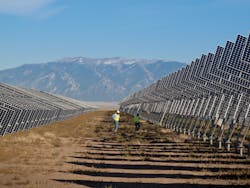What is in Biden's Proposed Budget for Energy?
The White House released President Joe Biden’s budget proposals for fiscal year 2024, which includes funding for distributed energy research, energy bill assistance, residential energy retrofits, wildfire readiness, cybersecurity and some infrastructure funding.
In total, DOE’s FY 2024 budget request is $52 billion.
According to a release by the DOE, the budget will help build a clean energy economy that supports new economic opportunities, drives new investments in clean energy projects across the country, and creates high-paying jobs for all Americans—many of which will not require a college degree.
According to a release by the Department of the Interior, budget request for DOI also provides increases totaling $38 million for wildfire preparedness, including more funding for aviation contracts, uncrewed aerial systems, and incident support. The requested budget for the Department of Agriculture also includes an increase of $16 million for the wildfire preparedness program and $183 million for hiring additional personnel.
“President Biden’s budget request reflects his unwavering commitment to building a clean energy future made in America and powered by American workers,” said U.S. Secretary of Energy Jennifer M. Granholm. “The budget provides DOE critical resources to transform the president’s historic clean energy investments and ambitious climate vision into reality—laying the foundation for an inclusive 21st century economy that lifts up communities everywhere while boldly facing the climate crisis head-on.”
The budget request includes:
The request provides $375 million—including $50 million for a new energy burden reduction program—to complete approximately 46,000 low-income residential energy retrofits through the Weatherization Assistance Program (WAP), making homes healthier and more efficient while driving down household energy bills. The budget also requests $52 million to expand the Weatherization Readiness Fund—increasing the number of homes WAP is able to serve.
In addition to the weatherization funding, nearly $750 million is requested to support energy efficiency and resilience in HUD-assisted and financed developments, $800 million for HHS LIHEAP funded efficiency upgrades, and $50 million to launch a new Energy Burden Reduction Pilot by DOE to lower energy costs while also reducing emissions through efficiency, electrification, and distributed energy resource installation retrofits in in at least 3,000 low-income households.
The president proposed funding of $8.8 billion for the Office of Science to support DOE’s scientists and their work. The proposed budget represents transformational investments in the Office of Science for clean energy, climate change, emerging technologies, workforce development, and moves the DOE closer to the authorized funding level provided by the president’s CHIPS and Science Act.
Within the $8.8 billion, the budget requests over $1 billion for the Fusion Energy Science Program to help develop commercialized fusion energy.
Reflecting the president’s support of historically Black colleges and universities and minority-serving institutions, the budget requests $35 million to start the process of standing up an 18th National Lab at these institutions—building upon DOE’s history of solutions-driven research and innovation. The president also requested $3.8 billion for DOE’s Office of Energy Efficiency and Renewable Energy (EERE) to spur development of clean energy technologies and create new economic opportunities.
The budget includes $83 million to electrify Tribal homes and transition Tribal colleges and universities to clean energy. It also includes $13 million to provide grid planning and technical assistance to Tribes and other communities to ensure they have access to clean and reliable electricity.
The president proposed $179 million for DOE’s Office of manufacturing and energy supply chains (MESC) and $173 million for nuclear isotope research and development to boost America’s global manufacturing competitiveness and build out reliable domestic supply chains free of influence from adversarial foreign nations.
DOE’s Office of Clean Energy Demonstrations proposed funding of $215 million will help catalyze historic private sector investments and accelerate new market-ready, commercial-scale technologies—reducing our reliability on foreign supply chains and laying the foundation for a strong domestic clean energy economy. The budget also requests $23.8 billion for the National Nuclear Security Administration (NNSA), the largest request in NNSA history.
The budget provides DOE's Office of Cybersecurity, Energy Security, and Emergency Response $245 million to address the evolving physical and cyber threats to the nation’s energy infrastructure. In addition, the administration supports the use of the Defense Production Act at DOE to support rebuilding domestic uranium production and enrichment capacity to establish a secure supply for the nation’s current and future nuclear fleet and also to reduce reliance on foreign supplies of uranium, as well as other clean energy technologies to ensure robust supply chains for electrical transformers and other critical grid components. The budget also includes $75 million in MESC for DOE to carry out the president’s recent determinations under the Defense Production Act.
According to a White House press release, the budget would invest $4.5 billion in clean energy. This includes, for example, nearly $50 million for the DOE’s Solar Energy Technology Office.
The budget also provides $30 million for grants and $1 billion for loan guarantees for clean energy systems and energy efficiency improvements for farmers and rural small businesses. It provides $6.5 billion in authority for rural electric loans to support additional clean energy, energy storage and transmission projects that would create good-paying jobs. In addition, the budget includes $15 million in funding to support the creation of the Rural Clean Energy Initiative to provide critical technical assistance to rural electric providers.
About the Author
Jeff Postelwait
Managing Editor
Jeff Postelwait is a writer and editor with a background in newspapers and online editing who has been writing about the electric utility industry since 2008. Jeff is senior editor for T&D World magazine and sits on the advisory board of the T&D World Conference and Exhibition. Utility Products, Power Engineering, Powergrid International and Electric Light & Power are some of the other publications in which Jeff's work has been featured. Jeff received his degree in journalism news editing from Oklahoma State University and currently operates out of Oregon.
